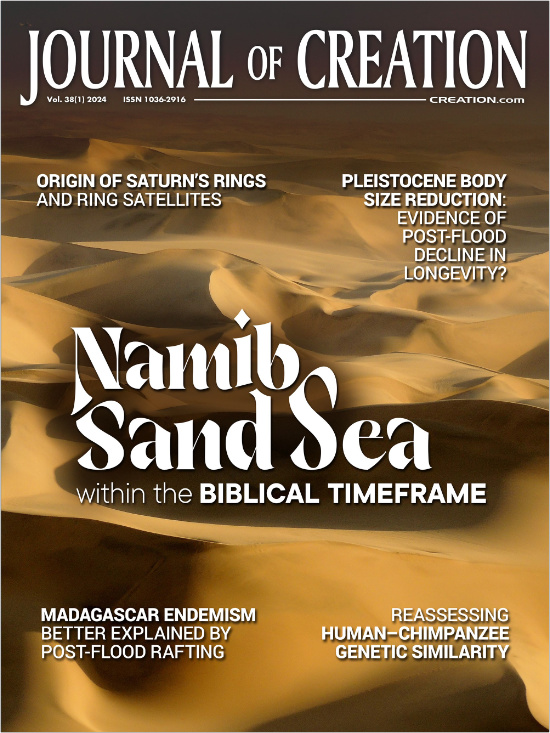Journal of Creation 38(1):54–59, April 2024
Browse our latest digital issue Subscribe
Enantiomeric amplification of L-amino acids: part 8—modification of eutectic point with special additives
About a third of biological amino acids (AAs) form racemic crystals which are less soluble than homochiral crystals in aqueous solutions. In principle, this allows a solution with an initial excess of one enantiomer to be further enriched. Some dicarboxylic acids increase or decrease the solubility of these racemic crystals, affecting the maximum enantioenrichment achievable. A study is critiqued here in which the enrichment effects were achieved by using unrealistic conditions, beginning with saturated solutions of concentrated amino acids at a fixed, controlled temperature with stirring. Under natural conditions, the proposed cycles of enrichment through cooling and desiccation, followed by partial dissolution in rainwater, would have rarely separated enriched solutions and instead would have diluted any co-solvent which raised the eutectic point. The maximum enantiopurity theoretically obtainable would have only been high enough to be biologically relevant for two AAs. However, no net increase in the L enantiomer would have resulted throughout nature. Instead, the initial enantiomeric excess needed for each amplification cycle would have racemized and mixed over time.
In this series, we have been evaluating various proposals from the Origin of Life (OoL) community on how a small enantiomeric excess (e.e.) of D- or L-amino acid (AA) could have been amplified naturally. In other words, a mixture already contained an excess of one enantiomer, and a method was proposed on how it might have been locally enriched. For two enantiomers, L and D, % enantiomeric excess (e.e.) is defined as (L – D)/(L + D) × 100.
One hypothesis for creating e.e. postulates preferentially extracting more of the desired enantiomer in some manner. Another hypothesis involves removing as much racemic mixture as possible, thereby concentrating the AA already present in excess. The total and average amount of D- and L-AA throughout nature would remain unchanged, but the goal is to separate the initial excess of L into another location. The fundamental question is whether the proposed methods leading to enrichment would occur naturally.
Enantiomeric amplification in the crystal phase
Pre-existing e.e. of AAs dissolved in water can sometimes be separated if racemic DL crystals are more or are less soluble than the homochiral crystals.1-3 Of the 19 proteinogenic amino acids containing an α-chiral carbon, two (threonine and asparagine) crystallize as conglomerates of distinct D and L crystals in equal amount.4-6 Isovaline, which is not part of the genetic code, has been identified in meteorites7 and also forms conglomerates of mixed D and L crystals.4 If an excess of the L enantiomer is present in solution, then slow cooling will cause the L crystal to crystallize first. If these crystals could be carefully separated before large amounts of D or racemic crystals form, then an e.e.L would be obtained.
Extracting enriched L-AA crystals in this manner would work for only two biological AAs, and the precisely controlled conditions necessary indicate that this would not occur naturally. Worse, nothing would prevent enriched L-AA crystals from redissolving later. If they never dissolved, they would have remained in crystal form and therefore be irrelevant for OoL speculations.
Enantiomeric amplification in the solution phase
The other seventeen biological AAs having D and L enantiomers form racemic crystals; i.e., the individual crystals contain the same amount of D and L enantiomers. Therefore, if a solution begins with an excess of L-AA and is carefully cooled so that DL racemic material crystallizes from solution, then the supernatant solution will be enriched in L enantiomer. The maximum ratio of L/D in the original solution for which the racemic crystal would still form first will determine the highest solution e.e.L attainable. Klussmann et al. called this the eutectic point for that AA at 25°C.8,1,9 At higher L/D ratios, racemic crystals won’t form first, so solution e.e. cannot be further enriched.
In experiments reported by Klussmann et al., saturated aqueous AA solutions containing 0 to 100% e.e.L were stirred for several hours or days at 25°C, producing the results shown in table 1 and table 2. Samples from the liquid phase were analyzed over time (after stirring for a few hours or days) using RP-HPLC (reverse phase high-pressure liquid chromatography) until equilibrium was established.1 The solution e.e. was then measured and compared to the initial e.e. (see table 1, table 2, and figure 1).
The saturated data points were used to create ternary phase diagrams (see figure 1). If a eutectic point existed, it would lie on the phase diagram curve.
The average of experiments 3 and 4 in table 1 is not 93.7% as reported, and presumably the researchers calculated the eutectic value from the average of experiments 4 and 5. Perhaps they discarded experiment 3 since the e.e. decreased with respect to the initial e.e. of the saturated solution when equilibration was complete.
The data in table 2 provide another example of the experimental concept. The researchers only tested an excess of L-AA and assumed quite reasonably that the D-AAs would provide the mirror image results in the phase diagrams.
Klussmann and collaborators provided a summary of the eutectic points they found for various biological AAs, as shown in table 3.8
Klussmann et al. also used the solubility ratio α [1] of AAs to predict the eutectic points reasonably well.10
α = [rac]/[ep] [1]
where [rac] and [ep] are the solubility of racemic and enantiopure mixtures.
The enrichment concept proposed was that even if the solution e.e. should be initially small, if racemic crystals could be removed through careful cooling, the solution would be enriched. By repeating this process several times, the e.e. at the eutectic point could be achieved.
Table 1. Distribution of D- and L-histidine in water at 25°C, beginning with an excess of L. Data from ref. 1 supporting information.
a Initial e.e. before crystallization; b e.e. measured in solution after equilibration and formation of some racemic crystals; c total solution concentration in 10−3 molar fractions; d solution concentration of pure enantiomer in 10−3 molar fractions; e total solution concentration in mg/g solvent; f average eutectic, experiments 3 and 4 according to the paper. Experiments 4 and 5 were probably meant.
a Original e.e. before crystallization; b e.e. measured in solution after equilibration and formation of some racemic crystals; c total solution concentration in 10–3 molar fractions; d solution concentration of pure enantiomer in 10−3 molar fractions; e total solution concentration in mg/g solvent; f average eutectic, experiments 4 and 5.
Critique of these studies
- Only two of the nineteen relevant AAs could be theoretically enriched to beyond an e.e. of 90%. Almost all would have remained unsuitable for biological purposes.11
- Stirring was required at a fixed temperature for some days to produce the crystals.
- The crystallization process would have required a large initial enantiomer excess in saturated concentration levels of AAs, completely unrealistic to have occurred naturally.
- In nature, cooling would have had to occur very slowly and then cease at just the right time before the homochiral crystals would begin to form.
- The liquid phase and crystals would somehow have to have completely separated from each other. The researchers deliberately began the next cycle with manually separated enantiomerically enriched solutions. How is this supposed to have occurred naturally? The solution phase would have mixed eventually with racemic AA dissolved elsewhere. In addition, the enriched solution phase and racemic crystals would have subsequently encountered rainwater, snow, hail, tides, dew, groundwater, water vapour, etc., leading to remixing.
- The theoretical maximum number of DL crystals would not have been removed each cycle; nor would both phases have been 100% separated naturally, as was done in the experiments. The total amount of extra L-enantiomer present in the solution phase at the end of each cycle would have steadily decreased, ending in insignificant amounts at any location. The researchers, however, concentrated L-enantiomer in one location by beginning each cycle with a new prepared solution having the eutectic e.e.L.
- Over geologic time, the racemic crystals would have had countless opportunities to redissolve, in particular due to temperature fluctuations. A single remixing event could have undone the effects of multiple enrichment cycles. Even neglecting contamination with AAs from the environment, remixed AAs possessing an e.e.L would have then been more likely to precipitate together, given the difficulty of forming only DL crystals. Furthermore, evaporation of the water would have occurred. In these more plausible scenarios, pure L would not have been separated to become available for prebiotic chemistry.
- The higher the e.e.L achieved, the more difficult it would have become in subsequent cycles to naturally remove racemic crystals. With no rapid stirring it would have become ever easier for homochiral crystals to accompany the racemic ones, given that L–L interactions would have been statistically so much more likely to form than L–D ones. The researchers used saturated solutions at a fixed 25°C to facilitate equilibration between the two phases. In nature, indiscriminate cooling, such as during night time or winters, would not have continually extracted only pure racemic crystals.
- Under natural, instead of guided, conditions, any theoretical enriched solutions combined would have remixed over long time periods during which any e.e. built up would have racemized.
Modification of eutectic composition via additives
Laboratory experiments demonstrated that co-crystallization of some small molecules with AAs could alter the relative heterochiral/homochiral solubility and thus tune the eutectic composition.1,10 For example, when valine co-crystallized with fumaric acid, its eutectic increased from 46% to 99% e.e. Similarly, proline’s eutectic composition increased from 50% to 99% e.e. when chloroform co-crystallized with the racemic compound, see figure 2.
Modification via additives
More than 80% of known chiral compounds crystallize as racemic mixtures instead of individual enantiopure solids. Therefore, the resolution of a chiral compound generally requires chiral acids or bases to form diastereomers with differing solubilities or methods to inhibit crystallization of the racemic compound.13
When a small e.e.L of an AA is dissolved, preferential precipitation of racemic crystals will automatically increase the e.e. of the solution phase. Separation of the just enriched solution followed by further precipitation of more racemic crystals will further increase the e.e. In the ideal case, enrichment of the solution could be steadily increased until the eutectic composition of D and L is reached. At that point, any more L present would be counterproductive, leading to L crystals precipitating first instead of racemic ones.
Sometimes solvent molecules can be incorporated into the crystal using hydrogen bonding to form solid structures known as solvates. In rare cases, mixed DL-AAs and added solvent molecules will be especially stable and thus less soluble in water. Therefore, solutions containing an initial excess of D- or L-enantiomer could be enriched in the liquid phase by crystallizing racemic mixtures.10
A series of molecules of putative prebiotic relevance were tested by Klussmann et al. to determine whether the e.e. of the eutectic is modified. They reported that
“Neither urea nor thiourea, nor any of a series of heterocyclic bases (cytosine, guanine, thymine, or uracil) had any effect on amino acid eutectic ee values in aqueous solution.” 10
An effect was found for some dicarboxylic acids though, see table 4.
In these experiments, typically ~50% e.e. of the AA being tested was combined with various proportions of additive at 25°C in aqueous solutions. The eutectic point represents the proportion of additive with AA leading to the highest % e.e. in the solution phase. Some additives lowered the AA solubility of pure D, pure L, and the DL racemic mixture, but of special interest was when the depression was greater for the racemic crystals.
In the case of threonine (thr) in table 4, the eutectic point contained no excess of L, meaning D and L were present in identical amounts. Beginning with more L than D in solution would have reduced the e.e. after crystallization, since for thr these crystals would be all L instead of racemic. But all the dicarboxylic acids shown in the table raised the eutectic point % e.e. of thr or had no affect (i.e., adipic acid), so now enrichment of the solution phase could occur by precipitating racemic crystals instead. This poses the obvious dilemma for the OoL community that the exact opposite effect would occur when the initial excess would be of D-thr.
The authors claimed
“… that the eutectic ee can change significantly in the presence of some acids, with solution enantioenrichment observed in many cases, except for methionine and histidine.”10
This is a somewhat misleading claim. In 12 cases (yellow boxes in table 4) the authors believe enantiomeric enrichment in solution occurred (being outside of measurement error) but we see that a depletion in e.e. was reported for thirteen cases (blue boxes in table 4).
Using all the data reported, one finds that the average e.e. in the presence of dicarboxylic acids was actually –2%, see table 4, rightmost column. The outcome of multiple ‘enrichment’ cycles would have produced a lower final e.e. than without the additives. Suppose that only one of the dicarboxylic acids had been present, would this help? No, from the rightmost column of table 4 we see that for all the additives except fumaric acid the net effect is to decrease the eutectic point. Furthermore, it would be unhelpful to explain the origin of only L biological AAs if an additive able to increase the eutectic point of some AAs would simultaneously decrease it for other ones.
The team found that enantiopure and racemic valine both produced crystals with fumaric acid using hydrogen bonding in a 2:1 ratio and that enantiopure and racemic phenylalanine produced crystals with fumaric acid in a 1:1 ratio.10 As shown in figure 3, at least ~20% as much fumaric acid as valine on a molar basis had to be present to obtain a discernible shift in eutectic at all, and valine displayed the strongest effect; i.e., the eutectic of 47% e.e. with no additive was increased to 99% with fumaric acid.
Solution phase enantioenrichment resulted when the solubility of the racemate was strongly suppressed relative to that of the enantiopure system. It is important to emphasize that racemic valine crystal solubility was lower under these conditions than the homochiral crystals only when ~20% or more moles of the solution was fumaric acid (see figure 3).
As explained above, higher eutectic points would have permitted higher e.e. to be achieved if repeated crystallization and decanting were carried out, in each case after carefully isolating the solution phase. The OoL notion was that cycles of rain and evaporation might have occurred in pools containing AAs and appropriate hydrogen-bonding partners if an e.e.L of the AA had been present initially. But how would this work? Evaporating the contents of a pool of water and then redissolving with new water would not change anything. The slightly enriched solution would have to be separated from the racemic crystals formed. But this necessary mobility of the solution phase would surely have diluted it with racemic AA found throughout nature. The racemic crystals formed would eventually also tend to redissolve over time.
Another obvious fact is that rainwater would dilute any other co-solvents present. Furthermore, multi-additive systems such as described above allegedly mimic the complex mixtures extracted from meteorites, including the dicarboxylic acids shown in table 4, but in nature the mixtures would have been vastly less concentrated.
Critique of these studies
- The proposed enantiomer enrichment mechanism would apply to only about a third of the biological AAs, and in almost all cases the best theoretical outcome would have produced too low an e.e. to be biologically useful.
- In about half the cases the eutectic would be lowered instead of raised, decreasing the maximum e.e. achievable for those AAs. However, to form viable proteins all the biological AAs except glycine would have to have been present in L form only.
- DL crystallization would have required considerably higher aqueous concentrations of AAs than expected to form under abiotic conditions. Bada estimated that the maximum concentration of AAs in ancient oceans would have only been about 10−8 g/l, which corresponds to a concentration of ~10−10 M.14
- Unrealistic high concentration of co-solvents like fumaric acid (the most promising additive found) was necessary to obtain a discernible shift in eutectic. Although the enrichment cycles could allegedly occur under natural conditions through partial redissolving with rainwater, followed by desiccation, this would have diluted the co-solvent throughout all the cycles.
- Enriched solutions would eventually have had to be translated far from the racemic crystals to avoid remixing, somewhere amenable to further relevant biochemical reactions.
- Desiccation would have produced a slurry of chemicals with very little AA present instead of pure racemic AA crystals.
- The slurry would not have been carefully cooled, nor a stirring mechanism have been provided by nature, to optimize the separation of DL and enantiopure crystals. During some cycles, very little racemic crystal might have precipitated; other times, a considerable number of the L crystals might have formed, but often some, or all, the material would have redissolved. Obtaining enriched solutions somewhere by chance would have required an enormous number of trials-and-errors during which much could have gone wrong, such as contamination with close to racemic AAs.
- A more plausible scenario would assume an initial e.e.L of ~2% in the initial solution instead of ~50%, and a much lower amount of diacid in the aqueous solution, mixed with many other chemicals. Obtaining >50% e.e. solutions under such more plausible natural conditions is not credible. During the endless cycles of forming and dissolving these slurries over vast time periods, any putative increase in e.e. would have simply accelerated the L → D enantiomeric inversion, eliminating the original L excess.
Final comments
These papers illustrate a common principle found in OoL publications, discussed by Truman in this journal.15 Experiments were executed under conditions that could not have occurred naturally, which the researchers knew were most likely to produce the desired results. Using realistic conditions would have consumed considerable research time, but nonetheless it would have been easy to perform some experiments which permitted extrapolation towards realistic conditions. The optimized results were claimed to support the possibility of abiogenesis, but this is not what objective evaluation of the data suggests. Experiments discussed above can be used to illustrate this principle.
Saturated AA solutions of ca. 10−3 M were used.1 However, Basa estimated AAs in prebiotic oceans would have concentrations of about 10−10 M.14 Stirring of a saturated AA solution at a controlled fixed temperature of 25°C maximized separation of racemic from homochiral crystal by facilitating rapid equilibration. Why were no experiments reported at lower initial AA concentrations, like 10−4 M (still a factor of 106 too high), with no stirring and using cooling cycles instead of a fixed temperature to reflect day vs. night temperatures and winter vs summer cycles? If after perhaps a year the researchers obtained no crystals, nor change in e.e., then this should have been reported and its significance for OoL purposes evaluated.
Other conditions should also be modified. Starting with absurdly high concentrations of dicarboxylic acid in water saves research time, but what happens at more realistic concentrations, like 1% – 10% of those used? Rainwater, tides, dew, etc. would have diluted the initial dicarboxylic acid and also during the subsequent cycles. Furthermore, AAs and dicarboxylic acids concentrated through evaporation would have been mixed with many other chemicals. Would pure racemic AA crystals form upon desiccation, or rather an amorphous slurry having no change in e.e.? Experiments could have been carried out by including many of the chemicals that the researchers reported as not affecting the eutectic. These chemicals dissolve in water and allegedly would have also been present under abiogenesis conditions.
Ironically, time is the evolutionists’ great enemy, as these multiple parameter adjustments made to reflect a more plausible natural setting would have dramatically hindered selective loss of racemic AA crystals from a solution. During the immense time intervals, the e.e. would have racemized and would also have mixed with racemic AA from elsewhere.
References and notes
- Klussmann, M., White, A.J.P., Armstrong, A., and Blackmond, D.G., Rationalization and prediction of solution enantiomeric excess in ternary phase systems, Angew. Chem. Int. Ed. 47:7985–7989, 2006 ǀ doi:10.1002/anie.200602520. Return to text.
- Breslow, R. and Levine, M., Amplification of enantiomeric concentrations under credible prebiotic conditions, PNAS 103:12979–12980, 2006 ǀ doi:10.1073/pnas.0605863103. Return to text.
- Breslow, R. and Cheng, Z-L., On the origin of terrestrial homochirality for nucleosides and amino acids, PNAS 106:9144–9146, 2009 ǀ doi:10.1073/pnas.090435010. Return to text.
- Viedma, C., Enantiomeric crystallization from dl-aspartic and dl-glutamic acids: implications for biomolecular chirality in the origin of life, Origins Life Evol. Biosph. 31:501–509, 2001 ǀ doi:10.1023/a:1012790523136. Return to text.
- Ref. 8 claims the two exceptions are threonine and arginine. Return to text.
- Tarasevych, A.V., Sorochinsky, A.E., Kukhar, V.P. and Guillemin, J-C., Deracemization of amino acids by partial sublimation and via homochiral self-organization, Orig. Life. Evol. Biosph. 43:129–135, 2013 ǀ doi:10.1007/s11084-013-9333-6. Return to text.
- Glavin, D.P., Elsila, J.E., McLain, H.L. et al., Evidence for extraterrestrial l-amino acid excesses in the CM2 Aguas Zarcas and Murchison Carbonaceous Chondrites: predictions for Ryugu and Bennu, 51st Lunar and Planetary Science Conference, 2020. Return to text.
- Klussmann, M., Iwamura, H., Mathew, S.P., Wells, D.H. Jr, Pandya, U., Armstrong, A., and Blackmond, D.G., Thermodynamic control of asymmetric amplification in amino acid catalysis, Nature 441:621–623, 2006 ǀ doi:10.1038/nature04780. Return to text.
- Chemists almost always used the term ‘eutectic’ in a different manner; see Eutectic, britannica.com. This makes Klussmann’s papers difficult to understand. Return to text.
- Klussmann, M., Izumi, T., White, A.J.P., Armstrong, A., and Blackmond, D.G., Emergence of solution-phase homochirality via crystal engineering of amino acids, J. Am. Chem. Soc. 123:7657–7660, 2007 ǀ doi:10.1021/ja0708870. Return to text.
- Truman, R., Racemization of amino acids under natural conditions: part 1—a challenge to abiogenesis, J. Creation 36(1):114–121, 2022. Return to text.
- Blackmond, D.G., The origin of biological homochirality, Cold Spring Harb. Perspect. Biol. 11:a032540, 2019 ǀ doi:10.1101/cshperspect.a032540. Return to text.
- Jacques, J., Collet, A., and Wilen, S.H., Enantiomers, Racemates and Resolution, Krieger Publishing Company, Melbourne, FL, 1991. Return to text.
- Bada, J.L., Amino acid cosmogeochemistry, Phil. Trans. R. Soc. Lond. B 333:349–358, 1991 ǀ doi:10.1098/rstb.1991.0084. Return to text.
- Truman, R., ‘Cleaning up’ and analyzing small data sets can distort conclusions, J. Creation 36(2):66–71, 2022. Return to text.







Readers’ comments
Comments are automatically closed 14 days after publication.